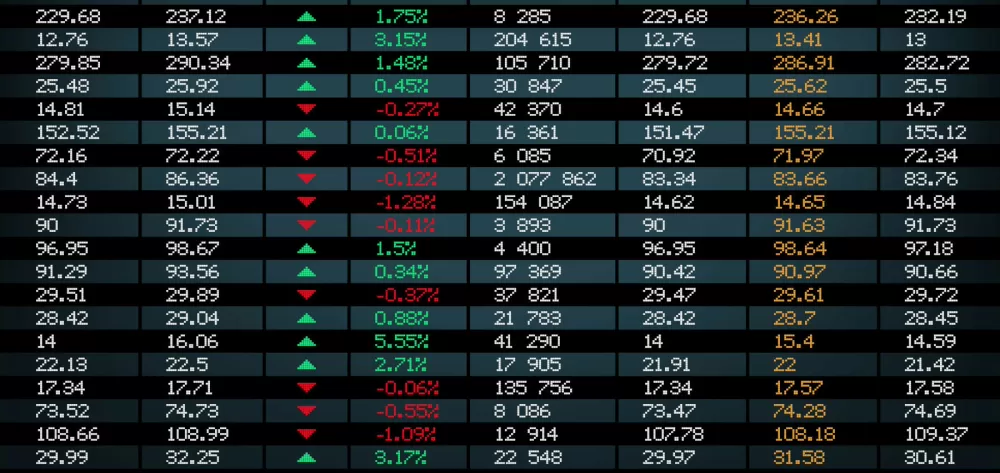Small publicly traded companies often play only a very marginal role in the portfolios of many investors. This guide explains what small-cap stocks are, and how you can invest in them.
What are small-cap stocks?
Small-cap stocks are the shares of smaller companies that are traded on stock exchanges. Their counterparts are mid-cap stocks (mid-sized companies) and large-cap stocks (large companies).
There are no universal criteria for dividing companies into small-caps, mid-caps, and large-caps. How stocks are classified normally depends on the stock exchange or the stock index publisher. Market capitalization is often used as the measuring rod.
Financial services provider MSCI, for example, categorizes stocks based on the company’s market capitalization. However, the differentiation between small, mid, and large-caps is not based on fixed thresholds.
Instead, MSCI assigns each category a fixed portion of an index. Companies included in the index are then sorted based on the combined value of their stocks. The MSCI ACWI IMI index, which covers around 99 percent of the global market capitalization, uses the following methodology:
- Large-caps (the biggest companies) make up around 70 percent of the market.
- Mid-caps (mid-sized companies) collectively make up 15 percent.
- Small-caps collectively make up around 14 percent.
- The remaining one percent is made up of micro caps. Not all service providers define this as a separate category.
It would be somewhat incorrect to define all companies with small-cap stocks as small companies. In many cases, these companies have revenues in the hundreds of millions or even in the billions.
What makes small-caps interesting for investors?
Although small-cap companies greatly outnumber bigger companies (mid and large-caps) in terms of numbers, they make up less of the worldwide market capitalization. Their weighting in global stock indexes is correspondingly low – if they are represented at all. For example, the MSCI World only includes mid-cap and large-cap stocks. Additionally, the weighting of different industry sectors can vary broadly between large- and mid-cap indexes and small-cap indexes. Targeted investments in small-cap stocks can help to counter these imbalances and further diversify your investment portfolio.
Which indexes track small-cap stocks?
There are many global stock indexes that specialize in small-cap stocks (see Table 1). There are also numerous country-specific indexes for small-cap stocks.
Table 1: Overview of select global small-cap stock indexes
| Index |
Number of stocks |
Number of countries |
Continents |
| FTSE Global Small Cap Index |
5833 |
50 |
Africa, Asia, Australia/Oceania,
Europe, North America,
South America |
| FTSE Global Small Cap ex USA Index |
4676 |
45 |
Africa, Asia, Australia/Oceania,
Europe, North America,
South America |
| MSCI ACWI Small Cap Index |
6167 |
27 |
Africa, Asia, Australia/Oceania,
Europe, North America,
South America |
| MSCI Emerging Markets Small Cap Index |
2052 |
24 |
Africa, Asia, Europe,
North America,
South America |
| MSCI World Small Cap Index |
4130 |
23 |
Asia, Australia/Oceania, Europe,
North America |
Source: Data published by index publishers. Date: June 4, 2024.
As is common with global stock indexes, US stocks normally make up the bulk of the index. Exceptions include the FTSE Global Small Cap ex USA Index, which explicitly leaves out US stocks. It is interesting to note that the ten biggest stocks in the MSCI World Small Cap only make up around two percent of the index (see Table 2). With most major large-cap stock indexes, the index is largely dictated by its ten biggest stocks.
Table 2: The ten stocks with the heaviest weighting in the MSCI World Small Cap
| Stock |
Country |
Sector |
Index weighting |
| Microstrategy |
USA |
IT, software |
0.30% |
| Emcor |
USA |
Construction |
0.24% |
| Pure Storage |
USA |
IT; software |
0.24% |
| Flex |
Singapur |
Electronics |
0.19% |
| Reinsurance Group of America |
USA |
Insurance |
0.18% |
| Nvent Electric |
USA |
Electrical engineering |
0.18% |
| Nutanix (A) |
USA |
IT, software |
0.18% |
| Topbuild Corporation |
USA |
Construction |
0.18% |
| Interactive Brokers |
USA |
Finance |
0.17% |
| Toll Brothers |
USA |
Real estate |
0.17% |
Source: Data published by index publisher. Date: June 6, 2024.
Which ETFs can I use to invest in small-cap stocks?
As a Swiss investor, you can invest in global small-cap indexes using either exchange-traded funds (ETFs) or index funds. Both of these fund types are normally passively managed, and provide a cost-efficient way to invest in the whole portfolio of stocks tracked by a stock index. The difference between an ETF and an index fund is that ETFs are traded on stock exchanges, while index funds are not.
Table 3: Selection of ETFs based on global small cap indexes
| ETF |
ISIN |
Domicile |
TER |
Dividends |
Replication |
| FTSE Global Small Cap ex USA Index |
Vanguard FTSE All-World ex-US
Small-Cap ETF |
US9220427184 |
USA |
0.08% |
Distributing |
Sampling |
| MSCI Emerging Markets Small Cap Index |
iShares MSCI Emerging Markets
Small Cap UCITS ETF |
IE00B3F81G20 |
Ireland |
0.74% |
Distributing |
Sampling |
| MSCI World Small Cap Index |
| iShares MSCI World Small Cap UCITS ETF |
IE00BF4RFH31 |
Ireland |
0.35% |
Accumulating |
Sampling |
Daten gemäss Anbietern. Stand: 04.06.2024. Diese Tabelle erhebt keinen Anspruch auf Vollständigkeit.
For Swiss investors, using a fund domiciled in Ireland is more favorable than using a US fund from a tax perspective. You can learn more in the moneyland.ch checklist for choosing an ETF.
Table 4: Selection of index funds based on global small-cap indexes
| Index fund |
ISIN |
Domicile |
TER |
Dividends |
Replication |
| MSCI World Small Cap Index |
| Global Small-Cap Index Fund - EUR Acc |
IE00B42W4L06 |
Ireland |
0.29% |
Accumulating |
Sampling |
| Global Small-Cap Index Fund - EUR Dist |
IE00BDCXSH02 |
Ireland |
0.29% |
Distributing |
Sampling |
| Global Small-Cap Index Fund - GBP Acc |
IE00B3X1NT05 |
Ireland |
0.29% |
Accumulating |
Sampling |
| Global Small-Cap Index Fund - GBP Dist |
IE00B3X1LS57 |
Ireland |
0.29% |
Distributing |
Sampling |
| Global Small-Cap Index Fund - USD Acc |
IE00B42LF923 |
Ireland |
0.29% |
Distributing |
Sampling |
Source: Data published by fund managers. Date: June 4, 2024. This table does not include all important data related to a fund.
Which indexes track Swiss small-cap stocks?
Only one index – the MSCI Switzerland – specializes in Swiss small-cap stocks, and it currently is not possible to invest in that index using an ETF or index fund (as per June, 2024). If you want to invest in Swiss small-cap stocks, you could consider the SPI Extra, for example. It includes around 200 small-cap and mid-cap Swiss companies, but mid-caps make up the larger share. You can learn more about this index in the guide to the SPI and the overview of Swiss stock indexes.
What are the risks of investing in small caps?
Many experts believe that small-cap stocks bear a higher risk of investment losses. Compared to many big companies, small-cap companies often have a more focused business model with a smaller range of activities. This can result in higher volatility. Small-cap indexes, on the other hand, are often already widely diversified simply because they contain so many different stocks. They provide a way to further diversify your ETF portfolio.
Some general risks always apply to investing in stocks. You may make losses both over the short-term or long-term, though the risk is substantially lower if you have a well-diversified portfolio of stocks. The risk of losing money is higher if you invest in just a few individual companies.
What kind of returns do small-cap stocks deliver?
A comparison of historical comparisons of stocks tracked by the MSCI World shows that between June 2014 and June 2024, the large-cap and mid-cap companies delivered better performance than small-caps (see Table 5). However, results can vary broadly depending on the timespan used. As a general rule, it is impossible to accurately predict the future performance of securities like stocks and ETFs. Past performance is never an accurate indicator of future performance.
Table 5: Performance comparison of large- and mid-cap stocks and small-cap stocks
| ETF/Index fund |
Performance in CHF (2014-2024) |
ISIN |
Index |
iShares Core MSCI World
UCITS ETF USD (Acc) |
143.39% |
IE00B4L5Y983 |
MSCI World
(large-caps und mid-caps) |
Global Small-Cap Index Fund -
USD Acc |
91.95% |
E00B42LF923 |
MSCI World Small Cap Index |
Source: Justetf.com and investing.com. Dates for calculations: June 3, 2014 and June 3, 2024.
Note: This article is provided for educational purposes only and should not be considered investment advice.
More on this topic:
Compare Swiss stock brokers now
How to invest money in Switzerland
The core-satellite investment strategy explained
The 70-30 portfolio investment strategy explained


 Deal of the Day
Deal of the Day 




